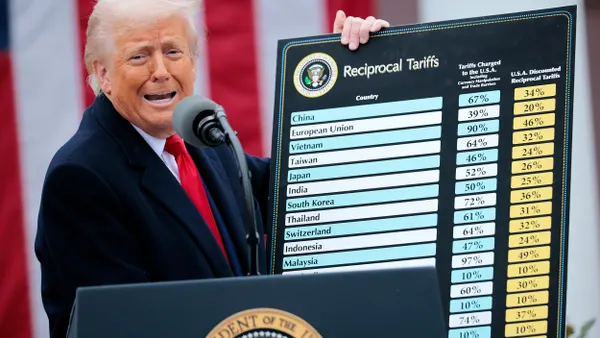Dive Brief:
- Sponsored ads that appear in Amazon baby registries are leading new parents to receive unwanted gifts and are subsequently facing flak for being deceptive, according to a report in The Wall Street Journal. The ads, from companies like Playtex, Johnson & Johnson and Kimberly-Clark, are automatically inserted into the registry as sponsored items and blend in closely with the actual wish-list products.
- The items look like the rest of the registry items, with a box featuring a photo, the product rating and price, as well as indicators telling if it's in stock, a yellow "add to cart" button and a "0 of 1 purchased" label. The only difference is that the ads contain a small gray "sponsored" label under the product photo.
- The FTC requires clear labels on native ads to identify them as paid content, as well as easy-to-read fonts and different colors that stand out. The agency has cracked down on search engines to more clearly highlight ads in brighter colors before. Sixty percent of sponsored ads are left in the registries, per internal Amazon presentations reviewed by Journal. But it's sometimes unclear whether new parents leave the ads in by choice or simply don't realize they are there. Amazon sells three native baby registry product placements each quarter for $500,000 a piece, according to the presentations. Brands are required to spend $500,000 to $3 million more on other Amazon ad formats.
Dive Insight:
As advertising becomes a bigger driver of growth for Amazon, the company is potentially starting to push the envelope in terms of what consumers find acceptable. Building out a baby registry business makes sense for Amazon since the service can be closely linked to its e-commerce platform, and similarly provides brands with an opportunity to reach shoppers primed to make a gift purchase.
But, per the Journal report, the service is flustering many since the lack of clear labels has ended up degrading the user experience and left parents with products they weren't asking for. Critics might see sponsored ads in baby registries as particularly intrusive, since they appear in an area that many users expect to be private and are targeted at the dollars of users' friends and family.
The confusion is a potential consequence of Amazon quickly saturating product and search result pages with sponsored ads as more brands pony up for the format. The publisher Recode in September conducted what it called an "unscientific test" gauging the volume of sponsored ads on the site and found it had spiked considerably. Roughly 8% of views on Amazon product pages were driven from sponsored links, doubling figures from the previous year, according to Jumpshot data included in the report. Separate research from Merkle revealed that spending on Amazon sponsored products increased 165% year-over-year in Q2 2018.
Native ads like Amazon's sponsored products are attractive to marketers because they can be embedded in regular content and aren't as easy to ignore or block out as traditional online banner ads. Spending on native ads is expected to account for 58.3% of the digital display market, or $32.9 billion, in 2018, according to eMarketer forecasts. Amazon is driving nonsocial native ad spending, which will increase more than 80% this year to reach $8.71 billion and represent 26.5% of all native expenditures, the researcher found.











